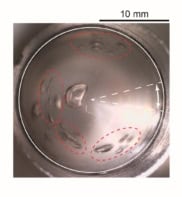The Curious Case of the Porpoises and the Wind Farm investigates the case of a wind farm in the North Sea that appears to be attracting harbour porpoises. A study in 2011 found that the population of harbour porpoises (Phocoena phocoena) in the vicinity of the Windpark Egmond aan Zee (OWEZ) is greater now than before the park existed. The film picks up the story in 2018, exploring the science and the politics of offshore wind, where competing needs require carefully considered solutions.
Comprising 36 wind turbines and within view from the town of Egmond aan Zee, OWEZ became the first offshore wind farm built off the Dutch North Sea coast when it began full operations in 2007. Common sense might suggest that imposing this infrastructure on a marine ecosystem could be permanently disruptive. In fact, the turbines’ foundations seem to have created a sheltered reef environment with new foraging opportunities for porpoises.
But while this appears to be a “have-your-cake-and-eat-it” result for a renewable energy, the bigger picture is far more complex. Notably, fishing is now prohibited at the Egmond aan Zee windfarm, which has led to a significant reduction in shipping traffic in the area. So is the thriving marine life just a product of the area becoming a protected zone? Presumably, many of those fishing boats are still active – so has it simply shifted the environmental impact elsewhere?
Some in the local fishing community were unhappy with the shipping ban, especially with the speed at which it came into effect and the lack of consultation. Rems Cramer, a fisherman based in the Hague, is part of a team advocating a return to the OWEZ fishing grounds using more sustainable practices. Meike Scheidat, a marine researcher from Wageningen University who led the 2011 study is sympathetic to the fishing community but has concerns about the reality of multiuse wind farms.
Cramer and Scheidat feature in The Curious Case of the Porpoises and the Wind Farm along with Henk Kouwenhoven an engineer from Dutch utility company NUON, which constructed the windfarm in partnership with Shell. Kouwenhoven speaks about the current state of the wind energy sector in the Netherlands, which is poised for rapid expansion. While Cramer, Scheidat and Kouwenhoven may disagree on certain procedural aspects, they are in clear agreement on one key point: more studies are needed to establish the environmental impacts of offshore wind parks during construction, operation and decommissioning.
Produced by Physics World journalist James Dacey and the independent filmmaker Saskia Madlener, The Curious Case of the Porpoises and the Wind Farm is the third film in our series of films about environmental challenges and their solutions. The first film, looked at how Mexico City’s unique geology makes it difficult to provide a reliable source of fresh water to citizens. The second film looked at efforts in the US city of New Orleans to adapt to live with increasing flood risk in the face of climate changes. You can see those films, along with a range of articles about how science and technology can help tackle environmental challenges, in our Sustainable Futures collection.



